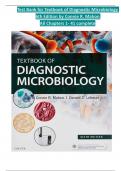Test Bank for Textbook of Diagnostic Microbiology
6th Edition by Connie R. Mahon
All Chapters 1- 41 complete
, Mahon:eTextbookeofeDiagnosticeMicrobiology,e6theEditioneTesteBank
Tableeofecontents
Parte1:eIntroductionetoeClinicaleMicrobiology
Chaptere1.eBacterialeCelleStructure,ePhysiology,eMetabolism,eandeGenetics
Chaptere2.eHost-ParasiteeInteraction
Chaptere3.eTheeLaboratoryeRoleeineInfectioneControl
Chaptere4.eControleofeMicroorganisms:eDisinfection,eSterilization,eandeMicrobiologyeSafety
Chaptere5.ePerformanceeImprovementeinetheeMicrobiologyeLaboratory
Chaptere6.eSpecimeneCollectioneandeProcessing
Chaptere7.eMicroscopiceExaminationeofeMaterialsefromeInfectedeSites
Chaptere8.e UseeofeColonyeMorphologyeforetheePresumptiveeIdentificationeofeMicroorganisms
Chaptere9.e BiochemicaleIdentificationeofeGram-NegativeeBacteria
Chaptere10.eImmunodiagnosiseofeInfectiouseDiseases
Chaptere11.eApplicationseofeMoleculareDiagnostics
Chaptere12.eAntibacterialeMechanismseofeActioneandeBacterialeResistanceeMechanisms
Chaptere13.eAntimicrobialeSusceptibilityeTesting
Parte2:eLaboratoryeIdentificationeofeSignificanteIsolates
Chaptere14.eStaphylococci
Chaptere15.eStreptococcus,eEnterococcus,eandeOthereCatalase-Negative,eGram-PositiveeCocci
Chaptere16.eAerobiceGram-PositiveeBacilli
Chaptere17.eNeisseriaeSpecieseandeMoraxellaecatarrhalis
Chaptere18.eHaemophilus,eHACEK,eLegionellaeandeOthereFastidiouseGram-NegativeeBacilli
Chaptere19.eEnterobacteriaceae
Chaptere20.eVibrio,eAeromonas,eandeCampylobactereSpecies
Chaptere21.eNonfermentingeandeMiscellaneouseGram-NegativeeBacilli
Chaptere22.eAnaerobeseofeClinicaleImportance
Chaptere23.eTheeSpirochetes
Chaptere24.eChlamydia,eRickettsia,eandeSimilareOrganisms
Chaptere25.eMycoplasmaeandeUreaplasma
Chaptere26.eMycobacteriumetuberculosiseandeNontuberculouseMycobacteria
Chaptere27.eMedicallyeSignificanteFungi
Chaptere28.eDiagnosticeParasitology
Chaptere29.eClinicaleVirology
Chaptere30.eAgentseofeBioterroreandeForensiceMicrobiology
Chaptere31.eBiofilms:eArchitectseofeDisease
Parte3:eLaboratoryeDiagnosiseofeInfectiouseDiseases:eandeOrganeSystemeApproachetoeDiagnosticeMicrobiology
Chaptere32.eUppereandeLowereRespiratoryeTracteInfections
Chaptere33.eSkineandeSofteTissueeInfections
Chaptere34.eGastrointestinaleInfectionseandeFoodePoisoning
Chaptere35.eInfectionseofetheeCentraleNervouseSystem
Chaptere36.eBacteremiaeandeSepsis
Chaptere37.eUrinaryeTracteInfections
Chaptere38.eGenitaleInfectionseandeSexuallyeTransmittedeInfections
Chaptere39.eInfectionseineSpecialePopulations
Chaptere40.eZoonoticeDiseases
Chaptere41.eOculareInfections
-
,Chaptere01:eBacterialeCelleStructure,ePhysiology,eMetabolism,eandeGeneticseMa
hon:eTextbookeofeDiagnosticeMicrobiology,e6theEditioneTesteBank
MULTIPLEeCHOICE
1. Toesurvive,emicrobialeinhabitantsehaveelearnedetoeadaptebyevaryingealleofetheefollowing,eexcept
a. growtherate.
b. growtheinealleatmosphericeconditions.
c. growtheateparticularetemperatures.
d. bacterialeshape.
ANSWER:e D
Theechapterebeginsebyediscussingetheewayemicrobialeinhabitantsehaveehadetoeevolveetoesurvivee
inemanyedifferentenicheseandehabitats.eItediscusseseslowegrowers,erapidegrowers,eandereplicati
onewithescarceeoreabundantenutrients,eunderedifferenteatmosphericeconditions,etemperaturee
requirements,eandecellestructure.eBacterialeshapeeaseaeformeofeevolutioneisenotediscussed.
OBJ:e Levele2:eInterpretation
2. Whoewaseconsideredetheefathereofeprotozoologyeandebacteriology?
a. AntonevaneLeeuwenhoek
b. LouisePasteur
c. CarleLandsteiner
d. MichaeleDouglas
ANSWER:e A
TheebookediscusseseAntonevaneLeeuwenhoekeasetheeinventoreofetheemicroscopeeandetheefirste
personetoeseeethee“beasties.”eSoetheyedubbedehimetheefathereofeprotozoologyeandebacteriolog
y.eTheeotherethreeeindividualsewereenotediscussed.
OBJ:e Levele1:eRecall
3. Prokaryoticecellsehaveewhicheofetheefollowingestructureseinetheirecytoplasm?
a. Golgieapparatus
b. Ribosomes
c. Mitochondria
d. Endoplasmicereticulum
ANSWER:e B
Alletheestructureselistedeareefoundeineeukaryoticecells,ebuteribosomeseareetheeonlyeonesetha
teapplyetoeprokaryoticecells.
OBJ:e Levele1:eRecall
4. ThiseformeofeDNAeisecommonlyefoundeineeukaryoticecells.
a. Linear
b. Circular
c. Plasmid
d. Colloid
, ANSWER:e A
CirculareandeplasmideDNAeareeusuallyefoundeonlyeinebacteria,enoteeukaryoticecells.eColloideiseae
propertyeofeproteinemoleculeseandeisenoteassociatedewithenucleotides.
OBJ:e Levele1:eRecall
5. Theenuclearemembraneeineprokaryoteseis
a. missing.
b. impenetrable.
c. aeclassicemembrane.
d. aelipidebilayeremembrane.
ANSWER:e A
Prokaryoticecellsedoenotehaveeanyemembrane-
boundestructureseinetheecytoplasmeincludingeaestructuredenucleus.
OBJ:e Levele1:eRecall
6. Aemicroorganismethateiseaeunicellulareorganismeandelackseaenuclearemembraneeandetru
eenucleusebelongsetoewhicheclassification?
a. Fungi
b. Bacteria
c. Algae
d. Parasite
ANSWER:e B
Fungi,ealgae,eandeparasiteseareeunicellulareeukaryoticeorganismsethatecontaineaetrueenucleu
s.eBacteriaeareeprokaryoticeandedoenotecontaineaetrueenucleuseorenuclearemembrane.
OBJ:e Levele1:eRecall
7. Inetheelaboratory,etheeclinicalemicrobiologisteiseresponsibleeforealletheefollowing,eexcept
a. isolatingemicroorganisms.
b. selectingetreatmenteforepatients.
c. identifyingemicroorganisms.
d. analyzingebacteriaethatecauseedisease.
ANSWER:e B
Clinicalemicrobiologistsedoenoteselectetheetreatmenteforepatients.eTheyeprovideetheedoctorewit
hetheenameeofetheeorganismeandetheeantibioticsethatecanekilletheebacteria,ebutenoteinetheefinales
electioneofetreatmenteprotocols.
OBJ:e Levele2:eRecall
8. Whateenablesetheemicrobiologistetoeselectetheecorrectemediaeforeprimaryecultureeandeoptimiz
eetheechanceeofeisolatingeaepathogeniceorganism?
a. Determiningestainingecharacteristics
b. Understandingetheecellestructureeandebiochemicalepathwayseofeaneorganism
c. Understandingetheegrowtherequirementseofepotentialepathogenseatespecificebodyesite
d. Knowingetheedifferenceseinecellewallseofeparticularebacteria
ANSWER:e C




